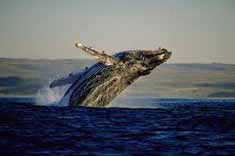South Africa has got to be one of the most incredible destinations worldwide for watching marine mammals. In early June, southern right whales leave their Antarctic feeding ground to frolic in the (relatively) warm waters of the Cape coast.
Here they mate, calve and generally hang out, occasionally flopping a tail up, or sticking their heads out of the water to check out the humans. They are so easy to watch.
In Cape Town, you can see them from the road, or even the train, anywhere along the False Bay coast, and they're distinctly visible on the western seaboard if you get high enough.
The town of Hermanus has proclaimed itself the whale capital of the world - and it's not far off. These huge beasts sometimes loll around mere metres from the shore, and they are clearly visible from the scenic and fragrant cliff-top walk.
Further east, the town of Plettenberg Bay also lays claim to the title of whale capital - with equally good reason. The southern rights are around for the whole season and, just when they're getting ready to leave in early November, the humpback whales arrive with their calves, and stay until the end of December or early January.
Occasionally Brydes whales or orcas are seen, and bottlenose and humpback dolphins are in residence all year. A breeding colony of Cape fur seals completes the assemblage of marine mammals.
It is in Plett that the dolphin and whale-watching industry is most organised, with boat trips, a dolphin-watching kayak operation and a number of aircraft from which you can check out the whales from the air. The town has made a huge effort to promote a responsible boat-based whale and dolphin watching programme. Viewing, distances and time spent with each animal are strictly monitored so that there is minimal interference.
You are certain to see Cape fur seals, and very likely to see bottlenose dolphins, and probably humpback dolphins too. Southern right whales are in the bay from about June to November, and migratory humpback whales are here briefly around May or June and then, on their return trip, from about November to February.
Boats are big, comfortable and moderately dry. Boarding is easy and people in wheelchairs can be accommodated. If you're feeling a bit more adventurous, you could paddle out in a sea kayak and the whales or dolphins may surface near you (they often do). Not as intimate, but fascinating nonetheless, the option also exists to fly over the bay.
Further up the coast in KwaZulu-Natal, humpback and bottlenose dolphins are also often seen from boats.
Source: South African Tourism








